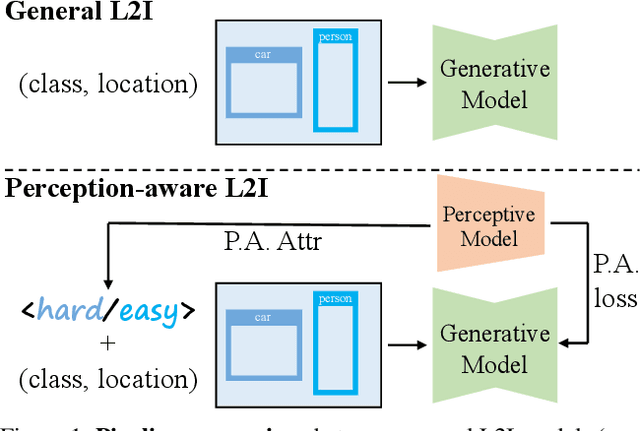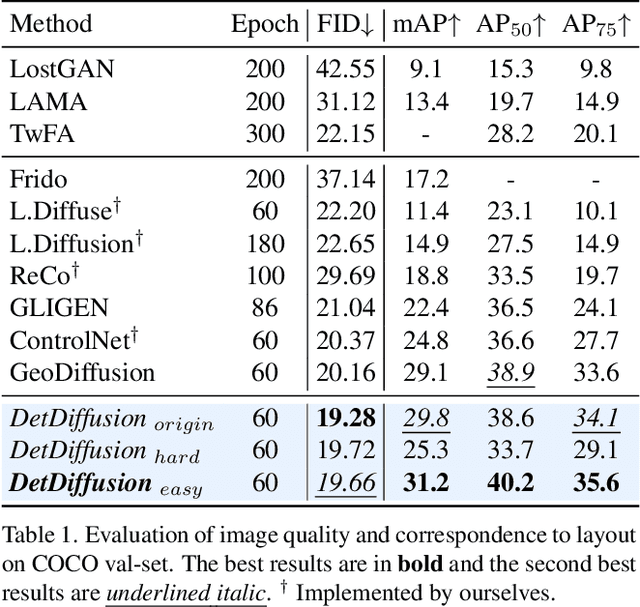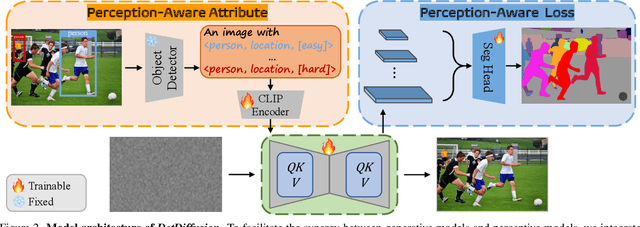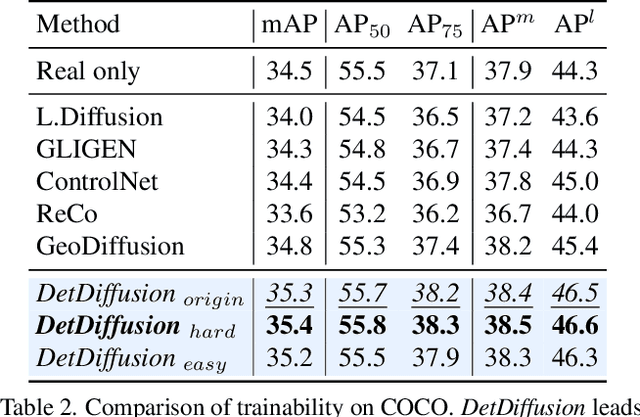Ruiyuan Gao
MagicDriveDiT: High-Resolution Long Video Generation for Autonomous Driving with Adaptive Control
Nov 21, 2024Abstract:The rapid advancement of diffusion models has greatly improved video synthesis, especially in controllable video generation, which is essential for applications like autonomous driving. However, existing methods are limited by scalability and how control conditions are integrated, failing to meet the needs for high-resolution and long videos for autonomous driving applications. In this paper, we introduce MagicDriveDiT, a novel approach based on the DiT architecture, and tackle these challenges. Our method enhances scalability through flow matching and employs a progressive training strategy to manage complex scenarios. By incorporating spatial-temporal conditional encoding, MagicDriveDiT achieves precise control over spatial-temporal latents. Comprehensive experiments show its superior performance in generating realistic street scene videos with higher resolution and more frames. MagicDriveDiT significantly improves video generation quality and spatial-temporal controls, expanding its potential applications across various tasks in autonomous driving.
MagicDrive3D: Controllable 3D Generation for Any-View Rendering in Street Scenes
May 23, 2024



Abstract:While controllable generative models for images and videos have achieved remarkable success, high-quality models for 3D scenes, particularly in unbounded scenarios like autonomous driving, remain underdeveloped due to high data acquisition costs. In this paper, we introduce MagicDrive3D, a novel pipeline for controllable 3D street scene generation that supports multi-condition control, including BEV maps, 3D objects, and text descriptions. Unlike previous methods that reconstruct before training the generative models, MagicDrive3D first trains a video generation model and then reconstructs from the generated data. This innovative approach enables easily controllable generation and static scene acquisition, resulting in high-quality scene reconstruction. To address the minor errors in generated content, we propose deformable Gaussian splatting with monocular depth initialization and appearance modeling to manage exposure discrepancies across viewpoints. Validated on the nuScenes dataset, MagicDrive3D generates diverse, high-quality 3D driving scenes that support any-view rendering and enhance downstream tasks like BEV segmentation. Our results demonstrate the framework's superior performance, showcasing its transformative potential for autonomous driving simulation and beyond.
Automated Evaluation of Large Vision-Language Models on Self-driving Corner Cases
Apr 16, 2024



Abstract:Large Vision-Language Models (LVLMs), due to the remarkable visual reasoning ability to understand images and videos, have received widespread attention in the autonomous driving domain, which significantly advances the development of interpretable end-to-end autonomous driving. However, current evaluations of LVLMs primarily focus on the multi-faceted capabilities in common scenarios, lacking quantifiable and automated assessment in autonomous driving contexts, let alone severe road corner cases that even the state-of-the-art autonomous driving perception systems struggle to handle. In this paper, we propose CODA-LM, a novel vision-language benchmark for self-driving, which provides the first automatic and quantitative evaluation of LVLMs for interpretable autonomous driving including general perception, regional perception, and driving suggestions. CODA-LM utilizes the texts to describe the road images, exploiting powerful text-only large language models (LLMs) without image inputs to assess the capabilities of LVLMs in autonomous driving scenarios, which reveals stronger alignment with human preferences than LVLM judges. Experiments demonstrate that even the closed-sourced commercial LVLMs like GPT-4V cannot deal with road corner cases well, suggesting that we are still far from a strong LVLM-powered intelligent driving agent, and we hope our CODA-LM can become the catalyst to promote future development.
DetDiffusion: Synergizing Generative and Perceptive Models for Enhanced Data Generation and Perception
Mar 20, 2024



Abstract:Current perceptive models heavily depend on resource-intensive datasets, prompting the need for innovative solutions. Leveraging recent advances in diffusion models, synthetic data, by constructing image inputs from various annotations, proves beneficial for downstream tasks. While prior methods have separately addressed generative and perceptive models, DetDiffusion, for the first time, harmonizes both, tackling the challenges in generating effective data for perceptive models. To enhance image generation with perceptive models, we introduce perception-aware loss (P.A. loss) through segmentation, improving both quality and controllability. To boost the performance of specific perceptive models, our method customizes data augmentation by extracting and utilizing perception-aware attribute (P.A. Attr) during generation. Experimental results from the object detection task highlight DetDiffusion's superior performance, establishing a new state-of-the-art in layout-guided generation. Furthermore, image syntheses from DetDiffusion can effectively augment training data, significantly enhancing downstream detection performance.
GuardT2I: Defending Text-to-Image Models from Adversarial Prompts
Mar 03, 2024Abstract:Recent advancements in Text-to-Image (T2I) models have raised significant safety concerns about their potential misuse for generating inappropriate or Not-Safe-For-Work (NSFW) contents, despite existing countermeasures such as NSFW classifiers or model fine-tuning for inappropriate concept removal. Addressing this challenge, our study unveils GuardT2I, a novel moderation framework that adopts a generative approach to enhance T2I models' robustness against adversarial prompts. Instead of making a binary classification, GuardT2I utilizes a Large Language Model (LLM) to conditionally transform text guidance embeddings within the T2I models into natural language for effective adversarial prompt detection, without compromising the models' inherent performance. Our extensive experiments reveal that GuardT2I outperforms leading commercial solutions like OpenAI-Moderation and Microsoft Azure Moderator by a significant margin across diverse adversarial scenarios.
Non-Cross Diffusion for Semantic Consistency
Nov 30, 2023Abstract:In diffusion models, deviations from a straight generative flow are a common issue, resulting in semantic inconsistencies and suboptimal generations. To address this challenge, we introduce `Non-Cross Diffusion', an innovative approach in generative modeling for learning ordinary differential equation (ODE) models. Our methodology strategically incorporates an ascending dimension of input to effectively connect points sampled from two distributions with uncrossed paths. This design is pivotal in ensuring enhanced semantic consistency throughout the inference process, which is especially critical for applications reliant on consistent generative flows, including various distillation methods and deterministic sampling, which are fundamental in image editing and interpolation tasks. Our empirical results demonstrate the effectiveness of Non-Cross Diffusion, showing a substantial reduction in semantic inconsistencies at different inference steps and a notable enhancement in the overall performance of diffusion models.
MMA-Diffusion: MultiModal Attack on Diffusion Models
Nov 29, 2023Abstract:In recent years, Text-to-Image (T2I) models have seen remarkable advancements, gaining widespread adoption. However, this progress has inadvertently opened avenues for potential misuse, particularly in generating inappropriate or Not-Safe-For-Work (NSFW) content. Our work introduces MMA-Diffusion, a framework that presents a significant and realistic threat to the security of T2I models by effectively circumventing current defensive measures in both open-source models and commercial online services. Unlike previous approaches, MMA-Diffusion leverages both textual and visual modalities to bypass safeguards like prompt filters and post-hoc safety checkers, thus exposing and highlighting the vulnerabilities in existing defense mechanisms.
MagicDrive: Street View Generation with Diverse 3D Geometry Control
Oct 13, 2023



Abstract:Recent advancements in diffusion models have significantly enhanced the data synthesis with 2D control. Yet, precise 3D control in street view generation, crucial for 3D perception tasks, remains elusive. Specifically, utilizing Bird's-Eye View (BEV) as the primary condition often leads to challenges in geometry control (e.g., height), affecting the representation of object shapes, occlusion patterns, and road surface elevations, all of which are essential to perception data synthesis, especially for 3D object detection tasks. In this paper, we introduce MagicDrive, a novel street view generation framework offering diverse 3D geometry controls, including camera poses, road maps, and 3D bounding boxes, together with textual descriptions, achieved through tailored encoding strategies. Besides, our design incorporates a cross-view attention module, ensuring consistency across multiple camera views. With MagicDrive, we achieve high-fidelity street-view synthesis that captures nuanced 3D geometry and various scene descriptions, enhancing tasks like BEV segmentation and 3D object detection.
DiffGuard: Semantic Mismatch-Guided Out-of-Distribution Detection using Pre-trained Diffusion Models
Aug 16, 2023Abstract:Given a classifier, the inherent property of semantic Out-of-Distribution (OOD) samples is that their contents differ from all legal classes in terms of semantics, namely semantic mismatch. There is a recent work that directly applies it to OOD detection, which employs a conditional Generative Adversarial Network (cGAN) to enlarge semantic mismatch in the image space. While achieving remarkable OOD detection performance on small datasets, it is not applicable to ImageNet-scale datasets due to the difficulty in training cGANs with both input images and labels as conditions. As diffusion models are much easier to train and amenable to various conditions compared to cGANs, in this work, we propose to directly use pre-trained diffusion models for semantic mismatch-guided OOD detection, named DiffGuard. Specifically, given an OOD input image and the predicted label from the classifier, we try to enlarge the semantic difference between the reconstructed OOD image under these conditions and the original input image. We also present several test-time techniques to further strengthen such differences. Experimental results show that DiffGuard is effective on both Cifar-10 and hard cases of the large-scale ImageNet, and it can be easily combined with existing OOD detection techniques to achieve state-of-the-art OOD detection results.
Out-of-Distribution Detection with Semantic Mismatch under Masking
Jul 31, 2022



Abstract:This paper proposes a novel out-of-distribution (OOD) detection framework named MoodCat for image classifiers. MoodCat masks a random portion of the input image and uses a generative model to synthesize the masked image to a new image conditioned on the classification result. It then calculates the semantic difference between the original image and the synthesized one for OOD detection. Compared to existing solutions, MoodCat naturally learns the semantic information of the in-distribution data with the proposed mask and conditional synthesis strategy, which is critical to identifying OODs. Experimental results demonstrate that MoodCat outperforms state-of-the-art OOD detection solutions by a large margin.
 Add to Chrome
Add to Chrome Add to Firefox
Add to Firefox Add to Edge
Add to Edge